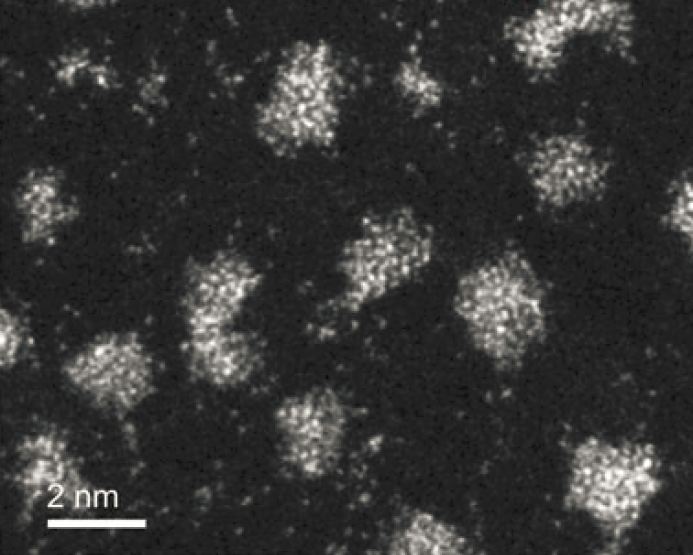Imaging individual atoms in a live catalytic reaction
July 15, 2013

Single atoms and irregular raft-like clusters of platinum sputtered on carbon imaged at 25 ◦C in vacuum (credit: Edward D. Boyes, Michael R. Ward, Leonardo Lari, Pratibha L. Gai/Annalen der Physik)
Researchers have observed and analyzed single atoms, small clusters, and nanoparticles in dynamic in-situ experiments for the first time, thanks to groundbreaking new electron microscopy technology developed at the University of York.
The research could open new opportunities for observing and understanding the role of atoms in reactions in many areas of the physical sciences. It also has important implications for new medicines and new energy sources.
So far, observing reacting atoms has been difficult. When studying the reactions at the catalyst surface, scientists usually have to look into idealized systems under vacuum conditions rather than examining the reality of an industrial catalytic process in a gas environment.
However, in a world first, the Directors of the York JEOL Nanocentre, Professor Ed Boyes and Professor Pratibha Gai, have developed atomic resolution in-situ aberration corrected environmental scanning transmission electron microscopy technology (in-situ AC-ESTEM) for catalyst reaction studies in realistic reaction conditions.
They imaged individual platinum atoms on carbon supports in a reacting catalyst under controlled atmosphere and temperature conditions. These materials are important in many applications, including fuel cells.
With the new technology, it is now possible to observe and analyze single atoms, small clusters and nanoparticles in dynamic in-situ experiments with controlled gas reaction environments at initial operating temperatures of up to 500◦C under transient reaction conditions.
“Our research opens up exciting new opportunities for observing and studying reacting atoms, the fundamental basic building blocks of matter, in many reactions and is especially important for the development of new medicines and new energy sources,” said Gai, Co-Director of the York JEOL Nanocentre and Professor of Electron Microscopy with Chairs in York’s Departments of Chemistry and Physics.
The work was funded by the Engineering and Physical Sciences Research Council (EPSRC).